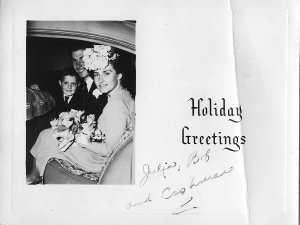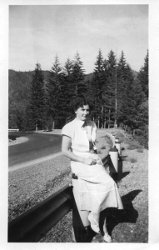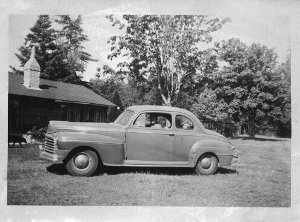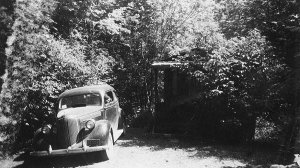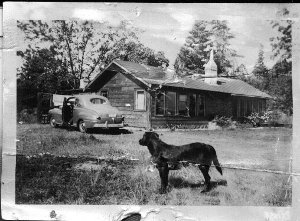Un-Conspicuous Consumption
Auto-biography: The Harris Family
by: Kim Wilson
March 19, 2009
Introduction
While interviewing my grandfather, Lyle Turner, about his first car, he was unable to recall many details except that, “it took all the money we had. I remember that.”1 From the year 1950 to 1970 the number of automobiles on American roads grew 250% from 40 million to 90 million.2 Through the purchase of their first automobile in 1958, Lyle and Betty Turner became a part of an increasingly mobile culture; however, whether limited by their income or personal priorities, they ignored the social consequences of their automobile choice, championing practicality over status.3 In an era obsessed with the automobile, Lyle and Betty Turner have never owned a new automobile. Their decision to purchase a used blue 1949 Chrysler in 1958 was not only driven by financial restraints, but also by personal choice: an aesthetically pleasing car was deemed frivolous.4 Although Lyle and Betty Turner are not emblematic of mid-century automobile culture, their acquisition of an automobile afforded them increased mobility for work, school and recreation. The Chrysler enabled the family to participate in many recreational activities including drive-in theatres and restaurants, camping and Sunday drives to the North Western Creamery.5 Lyle and Betty were unconcerned about how their car reflected their social status; however, their daughter, Alex Winfield, grew up amidst the automobile craze and therefore believed cars to have greater value. Similar to her parents, Alex was limited by financial restraints and thus was unable to purchase new cars for the majority of her life; however, her desire and love for new or beautiful classic cars reflects her acceptance of the car as a part of her identity. Through the telling of the Turner’s story, this paper will discuss how the acquisition of the automobile not only greatly increased the Turner’s mobility but also introduced their children the culture of the car.
Life without a Car
While Betty’s father owned a car for the latter half of her teen years, when the Turners purchased their first car in 1958, it was Lyle’s first experience owning a vehicle. After growing up in an orphanage in Victoria, Lyle attended Victoria Normal school for two years and then he attended the University of British Columbia (UBC) to compete his teaching degree.6 After graduating from UBC in 1947, Lyle moved to Victoria, began his career as an elementary school teacher and met Betty Marsden at a young adults’ church event.7 Betty Marsden was a widow with a 5 year old son.8 Her first husband, was a Naval Officer who had died in the Battle of the Atlantic shortly before the birth of her son, Cash.9 Since neither Lyle nor Betty had access to a car, the mobility of their courtship was limited. While courtship rituals were being drastically changed by the automobile because of the increased level of privacy afforded by the car, the Turners were bound to traditional forms of courtship.10 Rather than participating in drive-in and parking culture, Lyle would visit Betty in her family home.11 Lyle’s devotion to Betty out weighed the inconvenience of not having an automobile; while he was able to take the bus to her family home in the early evening, by the time he left her house at one o’clock in the morning, there were no longer buses running and he was forced to walk home from Oak Bay to Esquimalt.12 When I proclaimed my astonishment at the distance he walked, he responded, “[i]t must have been love.”13
Despite the fact that Lyle did not own his own car, he did have his driver’s license.14 Although personal mobility was not always available to Lyle, that did not exclude him from the growing desire to attain mobility: “[t]o teenagers and, indeed, for virtually all Americans, automobility meant personal freedom.”15 Betty’s father lent his car to Lyle and Betty not only for their wedding on August 5th, 1950, but also for their subsequent honeymoon down the Oregon Coast.16 The Turner’s first Christmas card featured a photo of the new family on their wedding day (see Figure 1). Noticeably, Betty chose to use a photo from their wedding day that incorporated the automobile. Whether or not this was a conscious choice, and I highly doubt that it was, the fact remains that the automobile was a special and exciting part of their wedding day. Culturally, the car was becoming increasingly a part of major events in an individual’s life: “[e]xemplary cars mark rites of courtship, marriage, death, and great public occasions; and romance has never been quite the same since the advent of America’s ‘love affair’ with cars.”17
Although Lyle and Betty did not have a love affair with the aesthetic aspects of the automobile, they loved the mobility that the car allowed them. Throughout their lives, the automobile facilitated their participation in many recreational activities.18 Figures 2 and 3 demonstrate that they were not only fascinated by the destinations that the automobile allowed them to access, but also the way in which they were able to get there.
While the photos focus primarily on Lyle and Betty, rather than changing the angle of the photo to use nature as the backdrop, they decided to use the road. They were on their first road trip, and while the road trip would later become a part of their daily lives, in 1950 neither Lyle nor Betty had yet to experience this level of personal mobility.
For the first eight years of their marriage, the Turners did not own a vehicle. 19 Lyle would either walk to work or get a ride from a fellow teacher; however, the rides were few and far between because only one teacher at his school owned a vehicle.20 Although automobiles were becoming increasingly accessible to the middle and lower class, during the early 1950s in Victoria they were not yet common place. Rae argues that, “[t]he transformation of the automobile from a luxury to a family necessity was noted in the 1920s as a direct consequence of the low-priced car.”21 Despite the fact that Lyle occupied a typically middle-class position, the Turners were unable to purchase a vehicle until 1958, suggesting that the American experience differed from the Canadian experience in that cars were not as accessible. Betty’s carless experience extended many years past their acquisition of a car because she did not get her driver’s licence until she was in her early 40s.22 Prior to getting her driver’s licence, Betty would take the bus downtown to Safeway, rent a cart from Robinsons Outdoor Store and do the family’s shopping once a week.23 When reflecting about their life before owning a car, the Turners had no complaints. Taking the bus, walking and receiving the occasional ride from a co-worker was a part of their daily life and nothing to be looked down upon.
Their First Car
The Turner’s purchased a 1949 blue Chrysler in 1958, at which point the family was already complete with four children ranging from baby to teenager.24 When asked what their motives were for purchasing the car, Julia laughed and said, “[t]o get around of course.”25 The car greatly increased the Turner family’s mobility. Automobiles were purchased for the range of activities that they facilitated, rather than for a specific purpose: “[t]he same vehicle could be used for travel to work, shopping, social visits, recreational travel, going to the doctor, or taking the children to school.”26 The Turner family was no different. For example, Robert drove the car to work, the family occasionally went to drive-in theatres or restaurants, and the family used the car for vacation.27 Prior to purchasing their automobile, the family’s recreational choices were limited rather than non-existent. The automobile not only increased their access to recreational activities but also introduced their family to automobile culture.
Unlike most North Americans, Lyle and Betty did not purchase their car to elevate their social status. The couple was either unaware of or ignored the social implications that their car reflected. As a teacher, Robert’s income was sufficient to purchase a decent vehicle; however, unlike the majority if the population, their car was not a priority.28 Foster argues, “[w]hat they wanted – what would really dictate their ultimate buying decision – was adult toys, with pizzaz and sex appeal.”29 While society was immersed in a love affair with the automobile, Lyle and Betty spent their money elsewhere. Their daughter, Alex, referred to the large quantity of crystal and silver that Lyle and Betty have accumulated over the years.30 Despite owning a vehicle, Lyle and Betty were disconnected from automobile culture. Since Robert had never owned a car before, he did not possess much car knowledge; consequently, he did not know that the oil had to be changed on a regular basis or that the shocks had to be replaced.31 It would be unfair to argue that Lyle and Betty did not want to own a vehicle; however, they may represent the minority who had the car forced upon them: “…none of the critics has ever explained the process by which cars were imposed on reluctant recipients.”32 Assuming the automobile was forced onto a small portion of society, it did not take long for those families to become accustomed to the benefits of the automobile: “American families possession of an automobile has become a feature of their life that they will give up with great reluctance and under extreme pressure of adverse circumstance.”33 This was true for the Turners. Although they never purchased a new vehicle, the couple continued and will continue to own a vehicle until they are unable to drive. After the demise of the Chrysler, the couple purchased an Oldsmobile, then a Chevy Two, then a Crown Victoria and finally their current car, a 2002 Toyota Camry.34 The mere fact that the Turners were unable to provide any additional information about their cars besides the make, model and colour further demonstrates that while they loved the personal mobility that the car afforded their family, they were not particularly smitten with the car itself.
Leisure: Drive-ins, Restaurants and Camping
While the Turners did not use their vehicle primarily for recreation, it was certainly the most memorable aspect of their car. Foster asserts, “[t]he automobile helped shape many of their leisure activities.”35 Undoubtedly, the acquisition of an automobile changed and expanded the family’s recreational activities. Drive-ins theatres were at the height of their popularity in 1958, coincidentally the same year that the Turners were able to purchase a vehicle.36 Drive-in theatres were a juxtaposition of rebellious teenage activities and wholesome family entertainment. One the one hand, drive-ins were given names like “…‘passion pits’ and others that should probably be left for the reader’s imagination.” 37 On the other hand, drive-ins were marketed to young families based on their affordability and convenience: “…leaders of the industry attempted to pitch drive-ins as ‘wholesome family entertainment’…Since many theatres charged a fixed price per vehicle, they traded on the idea that tired and overworked parents could take the whole family to double features at bargain prices.”38 While Lyle and Betty rarely took their family of six to the drive-in, their limited participation was due to their financial restraints rather than a lack of desire.39 Betty acknowledged that attending the movies associated negative connotations, but simultaneously asserted that “[Lyle] wasn’t as narrow as others.”40 As active members of the church community, the Turners did not participate in risqué recreation and according to the Turners, the drive-in did not fall into this category.
Both Lyle and Betty reflected fondly on the memories they had of going to drive-in restaurants; however, the reason they both enjoyed drive-in restaurants seemed to differ. While Robert particularly enjoyed the food, Julia said little of the food and focused on how “…it wasn’t too expensive. It was easy and they served you.”41 Although drive-in restaurants attracted many youth, the population that seemed to appreciate drive-in culture the most was mothers: “[y]oung, working-class families also patronized drive-in restaurants on a fairly regular basis. They sought quick, inexpensive meals, which would fill up the kids and keep them quiet and, in the bargain, provide brief respites from kitchens for tired, overworked wives.”42 The Turner family frequented Beacon Hill Drive-in and A&W.43 Although A&W restaurants were known for their “tray girls,” when asked, Betty asserted that the restaurant was not risqué and that she particularly liked the mascot.44 Drive-in restaurants not only created recreation for the entire family but also provided Julia brief respite from her daily family responsibilities.
Car camping was by far the most enjoyed and memorable experiences that the family had in relation to the automobile. Like many families across North America, the acquisition of the automobile enabled the family to go camping varying distances from their home. By 1971, 95% of visitors to National Parks in the United States arrived by car.45 For example, volume of visitors to Yellowstone Park grew from 35,000 people in 1917, when cars were not permitted, to 2 million in 1971.46 Moreover, “[t]he growth of such driving for pleasure is certainly a social benefit in that it gives to an increasingly urbanized civilization a ready outlet for recreation, either in the form of travel for its own sake or in providing easy and economical access to recreational facilities.”47 Lyle and Betty would pack their children, their belongings and their dog into their car and leave their urban dwelling annually from mid-August to Labour Day.48 They frequented Little Qualicum Falls, Mule Deer campsite in Manning Park, and the Okanagan.49 Also, the family occasionally rented a cabin at Shawnigan Lake (see Figure 5 and 6). One particularly comical memory was of the family driving to Little Qualicum Falls. Lyle had strapped the camping gear to the top of the Chrysler in a plywood box. As the car picked up speed, the box began to swaying back and forth.50 Whereas Betty panicked at the pending disaster that the unreliability of Lyle’s packing proposed, Lyle remained calm
throughout the entire drive, assuring Betty that everything was fine.51 Using the car for vacation was affordable and convenient for the entire family. Betty asserted that the ferry could not have cost more that fifteen dollars for the car and passengers and therefore even travelling to the mainland was not unattainable.52 Similar to the majority of North American families, the automobile enabled the Turners to escape their urban environment in favour of rural recreation.
A Car for the Girls
In 1975, Robert decided to buy a car for his daughters.53 His eldest daughter, Jen, was attending the University of Victoria and his younger daughter, Alex, was still in high school.54 Since Jen and Alex had grown up immersed in car culture, they were aware of how their car would reflect their social status as well as their identity. Alex admitted that as a child she had been ashamed of the cars that her family drove because they broadcasted the family’s limited income.55 While Foster recognizes that “[t]he vast majority of automobile-obsessed youth had to make do with hand-me-down”56 cars, Flink asserts that the family car could dictate children and youth’s social standing at school.57 Despite the fact that Lyle was unable to spend an enormous amount of money on a car for his daughters, he was able to satisfy the girls’ desires by purchasing a 1949 Austin Cambridge for one hundred dollars.58 The car was neither fancy nor reliable but it was cute: it was black, had leather interior, a wood dash, flip up signals that did not work and had rounded edges. 59 The Austin was the perfect car for the girls and they loved it.60 Although Alex valued the car’s aesthetic qualities over the car’s reliability, her love for the Austin demonstrates the illegitimacy of the stereotype that women did not love cars as much as men. Sanford addresses this stereotype when he discusses the fact that “…men tend to impute to cars more value than women tend to feel, yet have increasingly selected cars to please women.”61 Alex admitted that she when she was young she “was dying to find some boy who was into restoring antique cars.”62 Alex loved the automobile more intensely than her parents because of the culture that she grew up in: “[m]ovies, fiction, television, radio, and a host of other forms of human expression in the US were saturated with automotive imagery. The automobile culture and the emerging youth culture appeared to have a symbiotic relationship…”63 Considering the amount of automobile advertising and exposure that Alex experienced during her formative years, it is not surprising that she placed higher value on automobiles than her parents.
Undoubtedly, by purchasing Alex a car, Lyle increased her level of freedom. The very day that Alex turned 16 she got her driver’s licence.64 Although she would use the car for recreational purposes, the car’s primary use was to go to and from University.65 The car gave Alex an increased sense of control over her life. Before getting a car, Alex was forced to wait for Lyle to pick her up, who was notorious for arriving an hour late.66 The car allowed Alex to come and go as she pleased. Still, Alex’s relationship with the automobile was tainted by the poor quality of the cars that she owned. The second car that Lyle bought for his daughters was a 1961 oxidized blue Vauxhall.67 Alex described the car as “…ugly, serviceable, standard, 6-cylinder with manual breaks that were really hard to use.”68 In her last year at UBC, the Vauxhall blew up on the Oak Street Bridge in Vancouver, leaving her stranded.69 While a tow truck was able to take her to a mechanic, the mechanic was only able to temporarily fix the car. He warned Alex not to tamper with the car at all, but rather “to drive it into the ground.”70
While the Vauxhall survived the remainder of Alex’s degree, immediately following her graduation from UBC, Alex borrowed two thousand dollars from Lyle’s principal and bought herself a bright green Comet with black interior from Dave Wheaton in Victoria, B.C.71 With her teaching job, Alex was able to pay back the loan within a year; however, the decision to borrow money and purchase a car reveals Alex’s desire and necessity for the independence and mobility afforded by the automobile. Alex worked to pay her way through University, refusing to use student loans for her education, but had no problem borrowing a significant amount of money in order to purchase a car. Unlike her parents, who refused to spend more than absolutely necessary on a car, Alex valued the type of car that she drove not only for its aesthetic value but also for its reliability. While the Comet was not a particularly desirable car, it was a marked improvement over the Vauxhall. Alex’s aesthetic desires are representative of the majority of her female generation. Despite the lack of advertisement directed at women in mid-century, by the early 1980s, over 70% of Camaros being sold were purchased by women.72 Alex, like most women her age, loved the car not only for because it afforded her personal mobility but also for its aesthetic qualities.
Conclusion
Lyle and Betty Turner were introduced to automobile culture later in their life; consequently, their experience with the car was framed by their ignorance surrounding automobile culture. Whether they ignored the social implications of their automobile choice or were unaware of how their vehicle demonstrated their social status, Lyle and Betty loved their automobile because of the mobility that it afforded their family. While recreation was not their vehicle’s primary use, it was definitely their family’s most memorable use of their vehicle. Drive-in theatres, drive-in restaurants, and vacations were one of the ways in which the Turners participated in automobile culture. Still, the family was fairly disconnected from greater car culture in that they refused to invest much money in their vehicle and refused to learn much about the mechanics of the automobile. Alex’s relationship with the car represented how later generations were more accustomed to automobile culture because Alex grew up expecting the car to be present and being constantly exposed to the automobile advertising. Like her parents, Alex loved the mobility that the automobile enabled; but more than her parents, Alex grew to love the aesthetic aspects of the car as well. Overall, the Turner family’s relationship to the automobile does not represent the majority of mid-century families in North America; however, their participation in recreational activities demonstrates how the automobile greatly widened the population that was able to enjoy previously restricted rural recreation.
References
Flink, James, J. The Automobile Age. Cambridge: The MIT Press, 1988.
Foster, Mark S. The Nation on Wheels: The Automobile Culture in America since 1945. Belmont, CA: Thomson Wadsworth, 2003.
Harris, Julia. Interview by the author, 27 February 2009.
Harris, Julia. Interview by the author, 2 February 2009.
Harris, Julia. Interview by the author, 16 March 2009.
Harris, Robert. Interview by the author, 2 February 2009.
Rae, John B. The Road and the Car in American Life. Cambridge: The MIT Press, 1971.
Sanford, Charles, L. “‘Woman’s Place’ in American Car Culture.” In The Automobile and American Culture, edited by David L. Lewis and Laurence Goldstein. Michigan: University of Michigan Press, 1983, 137-152.
Wilson, Julia. Interview by the author, 2 February 2009.
Wilson, Julia. Interview by the author, 7 March 2009.
Endnotes
1 Robert Harris, personal interview, 2 February 2009. At the request of the author names have been changed. Foster, Mark S, The Nation on Wheels: The Automobile Culture in America since 1945, (Belmont, CA: Thomson Wadsworth, 2003), 65.
3 Julia Harris, personal interview, 2 February 2009.
4 Julia Harris, personal interview, 2 February 2009.
5 Jill Wilson, personal interview, 2 February 2009.
6 Julia Harris, personal interview, 2 February 2009.
7 Julia Harris, personal interview, 2 February 2009.
8 Julia Harris, personal interview, 2 February 2009.
9 Julia Harris, personal interview, 2 February 2009.
10 Robert Harris, personal interview, 2 February 2009.
11 Julia Harris, personal interview, 2 February 2009.
12 Robert Harris, personal interview, 2 February 2009.
13 Robert Harris, personal interview, 2 February 2009.
14 Julia Harris, personal interview, 2 February 2009.
15 Foster, Nation on Wheels, 67.
16 Julia Harris, personal interview, 2 February 2009.
17 Sanford, Charles, L, “Woman’s Place in American Car Culture,” in The Automobile and American Culture, edited by David L. Lewis and Laurence Goldstein, (Michigan: University of Michigan Press, 1983), 138.
18 Julia Harris, personal interview, 27 February 2009.
19 Julia Harris, personal interview, 2 February 2009.
20 Robert Harris, personal interview, 2 February 2009.
21 Rae, John B, The Road and the Car in American Life, (Cambridge: The MIT Press, 1971), 133.
22 Julia Harris, personal interview, 16 March 2009.
23 Julia Harris, personal interview, 16 March 2009.
24 Robert Harris, personal interview, 2 February 2009.
25 Julia Harris, personal interview, 2 February 2009.
26 Rae, The Road and the Car in American Life, 133.
27 Julia Harris, personal interview, 2 February 2009.
28 Julia Harris, personal interview, 2 February 2009.
29 Foster, A Nation on Wheels, 69.
30 Jill Wilson, personal interview, 7 March 2009.
31 Julia Harris, personal interview, 2 February 2009.
32 Rae, The Road and the Car in American Life, 153.
33 Rae, The Road and the Car in American Life, 136.
34 Julia Harris, personal interview, 2 February 2009.
35 Foster, A Nation on Wheels, 65.
36 Flink, James, L., The Automobile Age, (Cambridge: The MIT Press, 1988), 161.
37 Foster, A Nation on Wheels, 87.
38 Foster, A Nation on Wheels, 86.
39 Julia Harris, personal interview, 27 February 2009.
40 Julia Harris, personal interview, 27 February 2009.
41 Julia Harris, personal interview, 27 February 2009.
42 Foster, A Nation on Wheels, 90.
43 Julia Harris, personal interview, 27 February 2009.
44 Julia Harris, personal interview, 27 February 2009 and Flink, The Automobile Age, 161.
45 Rae, The Road and the Car in American Life, 140.
46 Rae, The Road and the Car in American Life, 140.
47 Rae, The Road and the Car in American Life, 141.
48 Julia Harris, personal interview, 27 February 2009.
49 Jill Wilson, personal interview, 2 February 2009.
50 Julia Harris, personal interview, February 27, 2009.
51 Julia Harris, personal interview, February 27, 2009.
52 Julia Harris, personal interview, February 27, 2009.
53 Jill Wilson, personal interview, March 7, 2009.
54 Jill Wilson, personal interview, March 7, 2009.
55 Jill Wilson, personal interview, March 7, 2009.
56 Foster, A Nation on Wheels, 66.
57 Flink, The Automobile Age, 159.
58 Jill Wilson, personal interview, March 7, 2009.
59 Jill Wilson, personal interview, March 7, 2009.
60 Jill Wilson, personal interview, March 7, 2009.
61 Sanford, “‘Woman’s Place’ in American Car Culture,” 143-144.
62 Jill Wilson, personal interview, March 7, 2009.
63 Foster, A Nation on Wheels, 65-66.
64 Jill Wilson, personal interview, March 7, 2009.
65 Jill Wilson, personal interview, March 7, 2009.
66 Jill Wilson, personal interview, March 7, 2009.
67 Jill Wilson, personal interview, March 7, 2009
68 Jill Wilson, personal interview, March 7, 2009.
69 Jill Wilson, personal interview, March 7, 2009.
70 Jill Wilson, personal interview, March 7, 2009.
71 Jill Wilson, personal interview, March 7, 2009.
72 Sanford, “‘Woman’s Place’ in American Car Culture,” 145.
